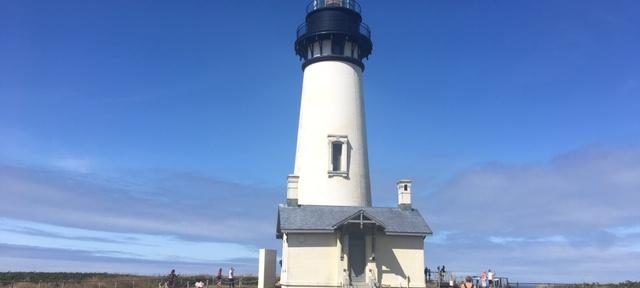Driving up or down the Oregon coast is truly a trip into history. Top that off with some of most scenic views you’ll find anywhere in America.
The Oregon Coast Highway 101 runs from north to south from historic Astoria to Brookings, an old redwood logging company town back in 1913 near the California border.
Lighthouses along the Oregon coast were mostly constructed by the U.S. Army Corps of Engineers between 1870 and 1896.Lighthouses along the coastlines were quite important to mariners whether you were captaining a large commercial vessel or a small fishing boat. The lighthouse was used as a navigational beacon to confirm the vessel’s position as well as to guide it away from dangerous rocky outcroppings.
Beginning in 1939 the U.S. Coast Guard took over guardianship of the lighthouses. All nine of Oregon’s surviving lighthouse stations are on the National Register of Historic Places.
Heceta Head Lighthouse
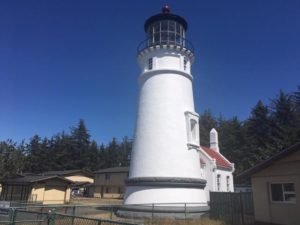
This lighthouse was named after Don Bruno de Heceta, a Spanish explorer. Heceta Head lighthouse is located north of Florence, Oregon.
The lighthouse was first lit in 1894 and stands 56 feet high and 205 feet above the ocean surface. To visit the lighthouse today requires about a half mile hike. Along the way you’ll see seabird nesting sites and a nearby Bed and Breakfast located in the assistant keeper’s home.
The short 1/2 mile hike to the top of the lighthouse from the parking lot is well worth the effort. At the lighthouse you’ll have spectacular views. The Heceta Head Lighthouse is open daily May-September and Friday-Monday during March, April and October.
Coquille River Lighthouse
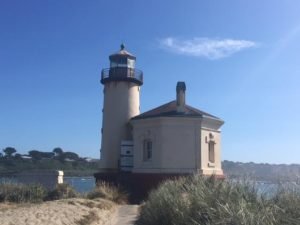
The Coquille River Lighthouse, the shortest lighthouse on the Oregon coast, was built in 1896. The main purpose of this lighthouse was to guide mariners across treacherous sandbars navigating into the Coquille River at Bandon, Oregon.
The lighthouse was decommissioned in 1939 after the U.S. Coast Guard took over the facility and decided it was no longer needed. To help navigation today, improvements to the river channel were made. Today’s navigation aid is an automated light on the south jetty.
The tower and interior of Coquille River Lighthouse are open to the public daily from about 11 a.m. to 5 p.m. from mid May through September.
Umpqua River Lighthouse
The Umpqua River Lighthouse is located over the beach where the Umpqua River flows into the Pacific Ocean at Umpqua Lighthouse State Park, South of Reedsport.
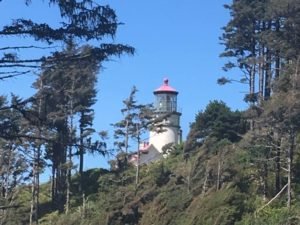
The lighthouse was built in 1890 and is 65 feet high. This replaced a lighthouse on the site which was built in 1857 as Oregon’s first lighthouse but was destroyed during a storm. The Umpqua River Lighthouse has a two ton First Order Fresnel lens constructed from 616 glass prisms handcrafted in France.
Visitors can tour the lighthouse daily year-round, 9 am to 6 pm. Tours are given by docents from the Umpqua River Lighthouse Museum. Inside the museum you’ll find hundreds of documents, photographs, and artifacts that illustrate the story of the Umpqua River Lighthouse. Today the site is used as a U.S. Coast Guard station.
Related Trips Into History articles are found on the links below..
Yaquina Head Lighthouse
Ninety Six foot tall Yaquina Head Lighthouse was constructed in 1873 shortly after the town of Newport, Oregon was founded. It was operated at first by the U.S. Lighthouse Board which changed to the U.S. Lighthouse Service until that department was closed in 1939. After the closure the site was taken over by the U.S. Coast Guard. This lighthouse was automated in 1966 and still operates now.
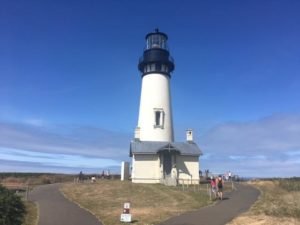
Of special note is the fact that the Yaquina Head Lighthouse is the only existing lighthouse in Oregon where the light keeper’s living quarters was in the same structure as the light itself. Another interesting fact was that the lighthouse was scheduled for demolition in the late 1940’s and early 1950’s but was saved by the town and historical societies.
The lighthouse was restored in 1974. Today the lighthouse is listed on the National Register of Historic Places. The lighthouse is open for limited ranger led tours, as weather, conditions and staffing permit. Reservations are required. You can call 541-574-3100 for the latest visitor information.
The Preservation of Historic Oregon Lighthouses
These are just four of the eleven lighthouses along the Oregon coast. As mentioned above, some of these lighthouses were scheduled for demolition but were saved by the efforts of historical societies, preservation societies and local governments.
It’s estimated that Oregon’s historic lighthouses receive over 2.5 million visitors yearly. Because weather along the coast can deteriorate structures over time, the need for donations to help preserve these important historical sites is an ongoing effort. A good site to visit regarding lighthouse preservation is https://www.oregonstateparksfoundation.org/oregons-lighthouses/
(Article and photos copyright Trips Into History)

